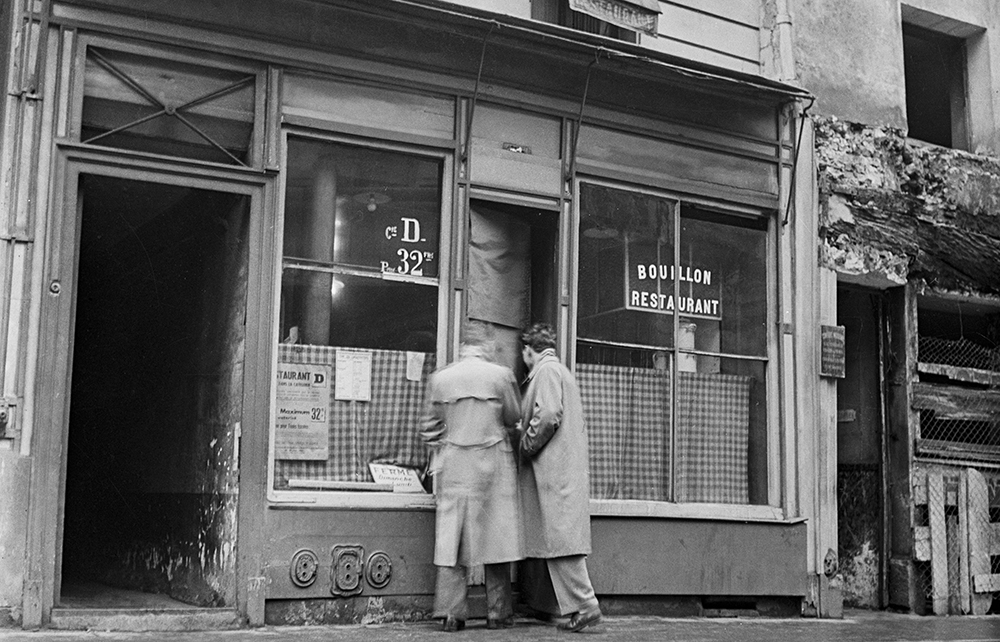‘Bald, overweight and gluttonous’ is how the American journalist and food writer A.J. Liebling described himself. Born in Manhattan in 1904, he wrote extensively about boxing and horse racing and was a war correspondent during the second world war, taking part in the Normandy landings in that capacity. He also recounted his gastronomic adventures in Paris before the war in Between Meals, a collection of essays largely derived from a four-part series, ‘Memoirs of a Feeder in France’, which ran in the New Yorker in 1959.
The sign of a good restaurant
might be seeing two priests or two ‘sporting girls’ eating together
As a gourmand (rather than a gourmet, a ‘snob word, and a silly one’), Liebling is dismissive of Proust’s madeleine, because the amount of brandy it contains ‘would not furnish a gnat with an alcohol rub’. In contrast, he writes approvingly about a chef who, while cooking ‘a choucroute, or sauerkraut, well garnie with pâté de foie gras, for three French senators… poured in a whole bottle of ancient cognac to improve the flavour’. It is perhaps unsurprising to find that Liebling developed gout.
As a writer, however, he manages the Proust-like achievement, increasingly enhanced by the passing of time, of resurrecting a vanished world through the remembrance of foods. Between Meals brings back in vivid snapshots the atmosphere of 1927 Paris, to where the young Liebling sailed from America to study medieval literature at the Sorbonne. In fact, he taught himself how to eat French food instead, explaining: ‘I use the verb “to eat” here to denote a selective activity, as opposed to the passive acceptance and regular renewal of nourishment, learned in infancy.’
In this endeavour he was supported by an innate sensibility – a relaxed intimacy with pleasure – which was not that of a puritan. Mocking a certain kind of American solemnity before a spree, he says of Henry Miller: ‘Arriving in Paris at 39, he wrote about la noce [debauchery] like a child making a belated discovery of the banana split.’ Rather, Liebling’s methodical approach is modelled, with knowing humour, on that of sports training. The serious feeder must practise daily, like a prize fighter, and exercise his tuyauterie (internal pipes) without ever neglecting the cheese course or the all-important second bottle of wine.
Liebling’s favourite kind of French cuisine has a ‘robust, classic quality, like a boxing style based on the straight left’. This includes ‘the whiting en colère (his tail in his mouth, as if contorted with anger)’, ‘the civets, or dark, winy stews of domestic rabbit or old turkey’ and, most crucially, ‘the foundation glory of all French cooking’, aromatic pot-au-feu, a piece of beef long simmered in expertly composed vegetable broth.
A ‘free particle’ in Paris, the young Liebling patronised Latin Quarter restaurants ‘neither chic nor sordid’ and learned, like a novice bridge player, what hand to play when composing the menus of his complex splurges. Not having too much money was an advantage: ‘In learning to eat, as in psychoanalysis, the customer, in order to profit, must be sensible of the cost.’ Before long Liebling knew how to spot the signs of a good restaurant – one where you might see two priests or two ‘sporting girls’ eating together, or one, like Maillabuau’s in rue Sainte-Anne, where ‘the men, for the most part, showed tremendous devantures [frontages] which they balanced on their knees with difficulty as they ate’.
Liebling’s Paris is a comestible world peopled with comestible characters. Of a fellow gastronome he writes: ‘His face in those days was the precise colour of the inside of a châteaubriand which is between rare and medium rare.’ On millinery matters he notes: ‘The cloche was an enlarged skull cap, jammed down on the head like an ice-cream scoop on a ball of vanilla.’ Chefs loom large. M. Pierre, of the eponymous restaurant in Place Gaillon, ‘has the appearance of a distinguished sinner in a René Clair movie’, while a Greek chef, born in Cairo, ‘must have measured six feet eight inches from the soles of his shoes to the top of the chef’s toque he always wore – one of the starched kind, shaped like an Orthodox priest’s hat’.
Returning to Paris in 1939, Liebling notices a decline. The grande époque of Parisian eating is over, partly, he thinks, as an effect of the demise of the great demi-mondaines (courtesans). Gone is the age ‘not only of the dazzling public suppers but of the cabinet particulier, where even a bourgeois seduction was preceded by an 11-course meal’. What makes this such a powerfully nostalgic book is also Liebling’s evocation of his private life between meals. The final pages are about a Parisienne called Angèle, whose room, ‘in the prow of a ship-shaped building, was barely wide enough for a single bed’, and provide an unexpected emotional jolt.






Comments